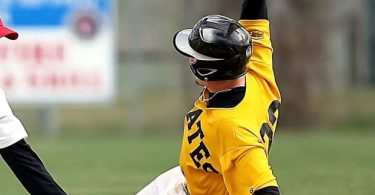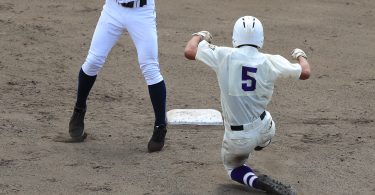The Situation: Runner on first, 2 outs, tie game in the 7th inning. Everyone knows that the runner on first wants to get into scoring position, but he doesn’t have great speed, so a straight steal is unlikely. The pitcher is holding the runner closely.
The Play: The pitcher comes set and checks the runner. As the pitcher goes into his delivery, the first baseman comes off the bag to get into fielding position. The runner begins his secondary lead – but instead of stopping, the runner takes two hard shuffles and takes off for second just as the pitch is crossing the plate. The first baseman has his back to the runner and doesn’t say anything. The second baseman and shortstop don’t break immediately to cover the bag, so the catcher double-clutches his throw.
The Outcome: The runner slides safely into second. The hitter singles on the next pitch, driving in the go-ahead run.
What Went Wrong?
The runner executed a perfect delayed steal, which is an incredibly hard play to defend against. A delayed steal mainly takes advantage of one of 2 players. First, if a catcher is lazy or tends to go to (or stay on) a knee to return the ball to a the pitcher, or keeps his head down after receiving, then a team will take advantage of the catcher. Second, a team will take advantage of whoever normally covers second on a steal (the shortstop or second baseman, depending on the hitter and the defense’s tendencies). If the middle infielders keep their heads down after the pitch, immediately turn their backs to the field, kick some dirt around after the batter takes a pitch, or seem to be generally ignoring the runner on first, an offense will take advantage of them. And make no mistake, in college, all these things will be noticed by the 2nd or 3rd inning, and a coach will wait to exploit the weakness until there’s a big situation late in the game.
Here, the delayed steal could have been prevented in a few ways. First, the first baseman needs to take responsibility for the runner, even while his back is turned. This is hard, but it can be done by just taking a quick peek back at the runner’s secondary, or perhaps more easily, by listening for the runner’s feet. It may sound weird, but a good first baseman can hear the difference between a normal secondary and a runner who is taking off for second. Give it a shot and really focus on listening.
The second baseman and shortstop also need to be checking the runner, both just before the pitch and just after, in order to get the best break possible to second base. The runner is in front of them, so they have no excuse if they get lazy and don’t check him.
Finally, the catcher in this situation needs to just throw the ball. A catcher’s job is to get the ball to second base. It is not his fault if there is nobody at second waiting for the throw. In fact, if his throw goes into center because nobody covered, he won’t hear a word of criticism from his coaches. Covering the bag is 100% on the middle infield.
The success of a delayed steal relies on using surprise to exploit laziness. By being mentally prepared for a delayed steal, you can almost always turn it into an easy out. With a runner on first in a delayed steal situation, remind your teammates to watch for the delay. Be vigilant about checking the runner. Do the little things right and you can prevent the other team from trying to sneak a delayed steal on you. Be prepared, and think the game.







